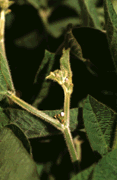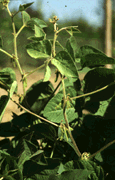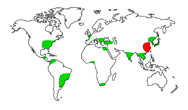Soya Bean (Glycine max)
Pea family
(Fabaceae)

| 
| 
|
| Soya plant in flower
| Soya plant with unripe capsules
| Soya bean pods
|
Source: Bock.D., MPI Köln; Margarine Institut, Hamburg
Distribution, Yield, Use:
Production (1000t) Yield (dt/ha)
| Country | 1979-81 | 1992 | 1979-81 | 1992
|
| USA | 55000 | 59800 | 19.9 | 25.3
|
| Brazil | 13500 | 19900 | 15.8 | 20.3
|
| China | 8300 | 9700 | 10.9 | 13.4
|
| Indonesia | 700 | 1900 | 8.76 | 11.2
|
| Canada | 650 | 1400 | 23.3 | 21.8
|
| World | 86000 | 114000 | 17.0 | 20.8
|
- Distribution:
Introduced into Europe and America in the last century.
The most important countries for cultivation are North
and South America, and China.
Prefers a warm climate and open soil, with
regular watering.
- Use:
Foodstuff
(cooking oil, protein products, vegetable)
Industrial raw material
(Paint, ink, adhesives, foam)
Animal feed (seeds, green material)
Soya beans contain 30-50% protein, 25% carbohydrate, 15-20% oil, of which ca. 50%
linoleic acid (C18:2).

Region of origin:  Region of cultivation:
Region of cultivation: 
- Cultivation and Breeding:
The soya bean is an East Asian food plant which has been cultivated in China since 1000 BC. The origins are not definitely known. The area of domestication has recently switched from Asia to America. There, soya has attained the significance of an internationally important agricultural plant. The soya plant is very sensitive to light conditions. Breeding of varieties suitable for a short tropical day and the longer days of the temperate zones has made the extension of the growing area possible. Distinction can be made between varieties with restricted or unrestricted stem growth and intermediate forms.
- Breeding aims:
A priority is increasing the yield, especially in the tropics, by breeding varieties suitable for local conditions. The transfer of resistance factors to fungus, leaf-eating insects, nematodes and viruses from wild and primitive varieties is in progress. Breeding for quality is concerned with varieties with high protein and oil levels.
Text by
Dr. Wolfgang Schuchert
Adapted to HTML by R.Saedler




 Region of cultivation:
Region of cultivation: 